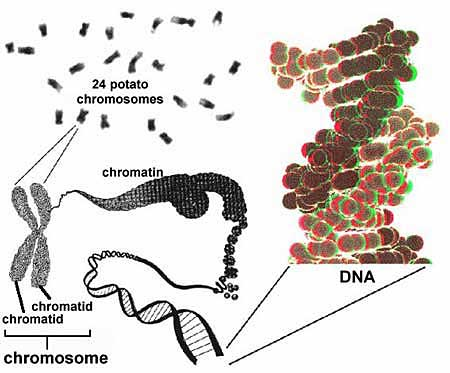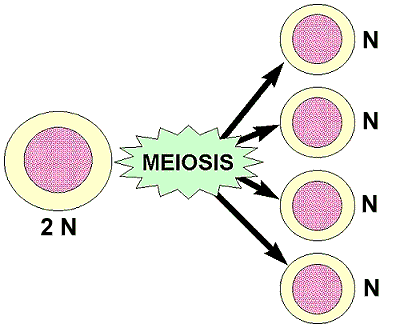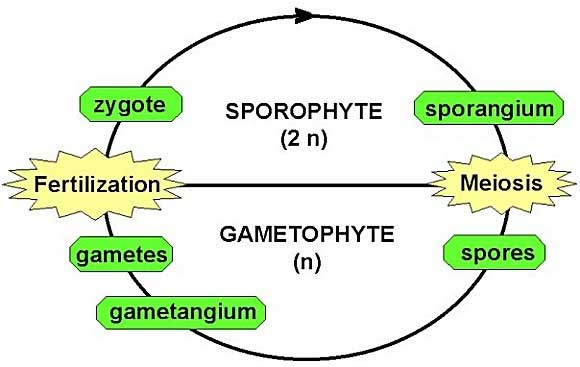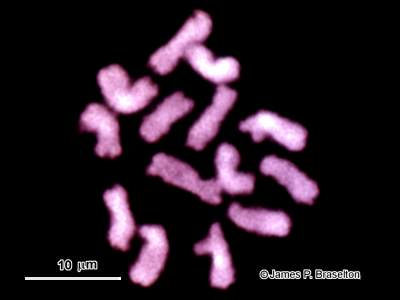Chromosomes and Plant Reproduction
In a previous reading, sexual reproduction was introduced because it is involved in the production of seeds in the flowering plants. In order to understand sexual reproduction for all plants, including those without flowers, we must look at what happens in plant cells, particularly with the nuclei. Part of this discussion will use plants and animals as examples to get across general principles that apply to both animals and plants.
Each eukaryotic cell contains a nucleus. The nucleus contains most of the cell's genetic material, i.e., the substance that contains the information for the cell to be the kind of cell it is, DNA. DNA is a major component of the substance that fills much of the nucleus, chromatin.

The 24 chromosomes of a wild relative, Solanum phereja, of the potato as seen through the light microscope. Each chromosome consists of chromatin, which contains most of the cell's DNA. (Note about the image: If you can get a pair of the red-green glasses for viewing 3D, the DNA molecule can be seen in 3D.)
When a cell prepares to divide as part of the formation of new cells, the DNA and the rest of the chromatin are duplicated. As the chromatin is distributed equally to the two new cells that are being formed from the original parent cell, the chromatin is seen to be contained in discrete structures known as the chromosomes. The process that the chromatin goes through as it is distributed to two new nuclei is known as mitosis.

How mitosis appears in cells of a onion root when viewed through a light microscope.
In summary, prior to the beginning of mitosis, the DNA and chromatin are duplicated. When the chromosomes start to appear in early stages of mitosis, each chromosome is seen to consist of two, identical halves, the chromatids. As mitosis continues, the two chromatids in each chromosome separate and go to new, separate nuclei of the newly forming cells. This results in the formation of two daughter cells with nuclei that are identical to each other in their DNA composition.
A very important point is that every organism contains a set of chromosomes in each cell that is characteristic for the organism. For example, every cell in an wild relative of the potato contains 24 chromosomes (see diagram above); every cell in a corn plant contains 20 chromosomes; every cell in a pea plant contains 14 chromosomes; every cell in a onion plant contains 16 chromosomes; every cell in a human contains 46 chromosomes. With your basic mathematical skills, you should note that the chromosome numbers given in the preceding sentence are even, i.e., divisible by 2. What causes the chromosome number in an adult human, a mature corn plant, a mature pea plant, and a mature lily to be even is explained by sexual reproduction.
Getting Two Sets of Chromosomes
The corn, lily, pea, and human all began when a sperm fused with an egg in the process known as fertilization. At that time one set of chromosomes was contributed by the sperm, and another set contributed by the egg. Looking at it another way, 7 of the 14 chromosomes in a pea came from the egg, 7 from the sperm. Or, there are two sets of 7 chromosomes each in every cell of a pea. One set of chromosomes is from the egg, the other from the sperm. For you, an example of a typical animal, of the 46 chromosomes in each of your cells, 23 were contributed by Mom's egg, the other 23 by Dad's sperm.
We use the notation "n" to represent one set of chromosomes. The 23 chromosomes in Mom's egg would be indicated by n = 23. Another term for n is haploid. Mom's egg was haploid. Dad's sperm was haploid. The haploid number for humans is 23. Mom's egg and Dad's sperm, therefore, had 23 chromosomes each.
After fertilization, the new cell that results from the fusion of an egg and sperm is known as a zygote. A zygote contains two sets of chromosomes, which is represented by 2n. One set of chromosomes came from the egg, and the other set from the sperm. The term for a cell that contains the 2n number of chromosomes is diploid. Diploid also is used as an adjective for an organism that consists of diploid cells. The zygote of a human has the diploid number of 46. The zygote of a pea contains the diploid number of 14. The zygote of the wild relative of the potato contains the diploid number of 24. Another way of representing this for the corn plant would be, 2n = 20. A corn plant is diploid, with 20 chromosomes (the 2n number of chromosomes for corn) in every cell. Each of you reading this sentence is diploid. For you, however, the number of chromosomes in each of your cells is 46, the 2n number of chromosomes for humans. Let's get back to the newly fertilized egg, the zygote.
From Zygote to the Adult
The zygote divides to form two, new cells. The nucleus of the zygote undergoes mitosis to distribute equal copies of chromatin to the two new nuclei, of which one each is in one of the two new cells. Each new cell contains a nucleus with the 2n number of chromosomes. Those two cells divide to form four cells, each of the 4 cells contains the 2n number of chromosomes. Cell divisions occur repeatedly, and eventually there are millions of cells in the organism.
The cells take on specialized functions in a process known as differentiation. In a plant, for example, some cells differentiate into leaf cells. Others into xylem cells, others into phloem cells, etc. In animals such as ourselves, examples of differentiated cells include white blood cells, nerve cells, skin cells, muscle cells, bone cells, and liver cells. From the standpoint of the chromosome numbers, all the cells in a mature organism contain the 2n number of chromosomes. For you that is 46 chromosomes. Twenty-three chromosomes in you can be traced back to Mom's egg prior to fertilization. The other 23 can be traced by to the sperm from Dad that fertilized Mom's egg. This principle holds true for plants as well, although we do not refer to "Mom" and "Dad" when talking about plants. In a mature pea plant, every cell contains the diploid number of 14 chromosomes in its nucleus. Seven of the chromosomes can be traced back to the egg that was fertilized by the sperm that contributed the other 7 chromosomes.
Introduction to Life Cycle Diagrams
One way to generalize and to simplify the principles in the preceding discussion is to use diagrams. For the pea plant, a diagram could look something like the following.

For you, the diagram would look something like this.

In general view, part of the life history of a pea plant, or any other seed plant, looks very similar to the life history for you, or any other higher animal. So we should keep in mind that there are some similarities between plants and animals when considering sexual reproduction, the reproduction that involves gametes. But there are some major differences which we are going to consider in the next portion of this reading.
Meiosis and Life Cycles
Now that you are a diploid adult with 46 chromosomes in each of your cells, you are capable of repeating in part what Mom and Dad did for you: Produce gametes, which, if under the right conditions, can fuse through the process of fertilization and thus produce a zygote, the first cell of a new diploid organism. If you are female, you produce eggs; if you are male, you produce sperm. Since we learned that the gametes of humans each contain the haploid number of chromosomes, the gametes you produce likewise will be haploid.
In human females, the ovaries contain specialized cells that will divide through a special type of cell division in which the nuclei go through what is known as meiosis. The specialized cells will produce eggs. In human males, the testes contain specialized cells that will divide through meiosis and produce sperm. The process of meiosis is a type of nuclear division that changes the diploid (2n) number of chromosomes to the haploid (n) number.

For these on-line readings we will not go through the details of meiosis or into some of the genetic consequences that result when nuclei go through meiosis. Those important details can be covered in other readings either on-line or in biology textbooks. We do want to emphasize, however, that it is meiosis that converts diploid cells into haploid cells. For humans and other higher animals, this occurs during the formation of gametes. If we added this to the diagram introduced a few paragraphs ago, we would get this.

For plants, we see a different scenario. Meiosis occurs in flowering plants within the flowers. In future lessons we will look at some of the details in the different groups of plants as to where meiosis occurs. But for now, what we want to note is that when meiosis occurs in plants, such as in the flowers of flowering plants, the immediate meiotic products ARE NOT GAMETES! In plants, the immediate products of meiosis are single, haploid cells called spores. SPORES! IN PLANTS, MEIOSIS PRODUCES SPORES!
Spores develop into plants. Since spores are haploid, the plants that spores form are haploid. The haploid plants will produce the gametes, the egg and sperm. What we have come to in our comparison of sexual reproduction between animals and plants is that plants are more complicated than animals because plants have an additional set of plants, the haploid ones that develop from spores, in between meiosis and the formation of the gametes.
A lot of plant biologists spend their lives studying how different groups of plants form their spores during meiosis, how the spores develop into the haploid plants, and how the haploid plants produce gametes (eggs and sperm) that fuse during fertilization to form the zygote. This is where we started: The zygote is 2n and will develop into a mature, diploid plant.
The Generalized Plant Life Cycle
To summarize the sequence of the major events in the life histories of plants, we can use the stylized diagram that is below the following terms. Note that there are some new terms in the diagram. These are important: You should learn them so well that you could define them in your sleep.
- sporophyte: diploid plant that produces spores through meiosis
- sporangium (-a): structure on a plant where meiosis occurs and spores are produced
- spore: haploid meiotic product in plants, the first cell in the gametophytic generation of plants
- gametophyte: haploid plant that develops from a spore, produces gametes
- gametangium (-a): structure on a gametophyte that produces gametes
- antheridium (-a): gametangium that produces male gametes (sperm)
- archegonium (-a): gametangium that produces female gametes (eggs)
- meiosis: division that produces cells with nuclei with the haploid chromosome number from a diploid cell
- fertilization: the fusion of gametes and their nuclei to form a zygote
- zygote: a fertilized egg, the first cell in the sporophytic generation of plants

This diagram is generally considered to depict the "life cycle" of a plant. By using the term "life cycle," we are looking at how a plant starts out at one point, such as the zygote, and goes through a developmental sequence that eventually gets the plant to a stage where it contributes to the formation of new plants that are at the same stage of development from which the original plant started.
Using the pea plant as an example, it started when an egg was fertilized by a sperm to form the diploid zygote. The zygote divided mitotically to form two cells; those two cells divided to form four cells; those four divided to form eight, and so on and so forth until we could see a multicellular plant that we recognize as a pea plant with roots, stem, leaves, and flowers. This is the sporophyte, with each cell containing the 2n number of chromosomes. For the pea this is 14.

The 14 chromosomes in a root cell of a pea plant as seen with confocal scanning laser microscopy.
We will look at the next things that happen in more detail in a later reading, but for now we want to note that in the flowers are the sporangia. The sporangia contain cells that go through meiosis to produce spores. The spores develop into microscopic, haploid plants, the gametophytes. The gametophytes produce the eggs and sperm, which will fuse to form a new zygote. We have just completed the life cycle of a pea plant!
As we go through other readings at this site, we will be looking at details of the life cycles of different types of plants. If we do this in an orderly fashion, we will eventually work our way back to the pea and other plants with flowers to fill in all the details of sexual reproduction. Once we have looked at the ways plants reproduce sexually, we also will have a better understanding of the importance of well-known plant structures such as flowers. We likewise will be able to answer practical questions about the significance of seeds, how seeds develop, what parts of seeds we use for food, and the development and structure of fruits.